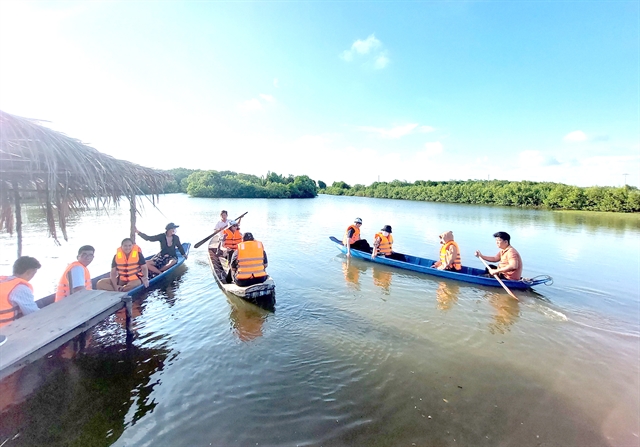Following the merger on July 1, the newly formed Vĩnh Long has a 130km coastline, an area of more than 6,200 sq.km and a population nearing 4.2 million, opening up new opportunities for tourism development.

Visitors enjoy a rowing boat trip through the mangrove forest in Bảo riverine island in Vĩnh Long Province. — VNA/VNS Photo Chương Đài
VĨNH LONG — Vĩnh Long Province has great potential for tourism development with diverse products after its administrative merger with Bến Tre and Trà Vinh provinces.
Following the merger on July 1, the newly formed Vĩnh Long has a 130km coastline, an area of more than 6,200 sq.km and a population nearing 4.2 million, opening up new opportunities for tourism development.
The Cửu Long (Mekong) Delta locality boasts vast orchards, a dense river and canal network, as well as many historical and cultural sites.
Lâm Hữu Phúc, deputy director of the province's Department of Culture, Sports and Tourism, said the province could now develop tourism routes linking inland orchard areas to the sea, offering visitors a rich and varied travel experience.
This would boost tourism revenue while promoting the growth of related services such as accommodation, food and drink, transport, and handicrafts, he said.
These developments were expected to generate thousands of new jobs for local residents, improve living standards, and contribute to the province’s overall economic growth, he said.
In the coastal commune of Thạnh Hải, pristine landscapes, fresh air, historical relics and rich cultural heritage make the commune highly attractive to visitors.
Phan Thị Kim Quí from Đồng Tháp Province’s Cao Lãnh Ward visited Bửng Islet in Thạnh Hải Commune during this summer holiday.
“Although the sea here is not crystal clear and the sand is not white, it has a distinctive charm shaped by the alluvial coast,” she said.
Besides swimming and enjoying seafood, her family also visited Ông Nam Hải Temple, which houses two giant whale skeletons, a sacred symbol for coastal communities.
They also toured the Hồ Chí Minh Trail at Sea memorial site, which used to be a key landing site for weapons transported from the North to support the Southern battlefield.
The visit honoured the bravery of those who risked their lives on this maritime supply route and deepened their pride in the nation’s heroic past, Qúi said.

Visitors experience green tourism along the roads of An Hội Ward in Vĩnh Long Province. — VNA/VNS Photo Chương Đài
Post-merger, Vĩnh Long has the largest coconut growing area in the country and is home to one of the largest populations of Khmer people in the Mekong Delta.
Tourism service providers in the province have taken advantage of the merger to expand their services.
Trì Văn Nghiệp, director of Vinh Binh Travel Trading Company Limited in Trà Vinh Ward, said the province’s tourism had developed unique features after the merger.
“These include the coconut-growing culture, Khmer heritage, traditional pottery villages, a strong connection with nature and friendly local people. They are the core values that businesses rely on to build distinctive tourism products and attract visitors in the long term,” he said.
The company had launched a tour connecting a floating coconut market on the Thom River located between Mỏ Cày and Nhuận Phú Tân communes and Hô riverine island in An Tường Commune, he said.
"This tour has received warm responses from many international travel agencies. It marks an early success and is expected to bring more visitors to the province," he said.

Wave-reducing embankments in Vĩnh Long Province have been built to protect the coastline from erosion and to support the upgrading and development of coastal tourism. — VNA/VNS Photo Chương Đài
The province welcomed over 5.1 million visitors, including 676,000 foreigners, in the first half of this year.
Total tourism revenue exceeded VNĐ4 trillion (US$153 million) during this period.
With its recently expanded boundaries and diverse landscapes ranging from fruit-growing areas to the sea, the province holds great potential for developing new inter-regional tours such as river cruises, orchard homestays, and eco-tourism routes connecting riverine islands to urban centres.
The province’s tourism environment remains largely unspoilt by urbanisation, making it ideal for resort, cultural, and eco-tourism.
It focuses on developing community-based tourism, river and waterway experiences, traditional festivals, coastal retreats, and agro-tourism.
It will improve linkages with nearby provinces such as Đồng Tháp and Tây Ninh, and Cần Thơ City, positioning Vĩnh Long as a strategic transit and stay-over destination.
Nguyễn Thị Quyên Thanh, deputy chairwoman of the provincial People’s Committee, said the province's Tourism Association should be a strong advocate and reliable partner for businesses.
She encouraged it to unite capable, dedicated enterprises to improve service quality, renew products, adopt digital tools, and build tourism on a foundation of smart resource use while preserving local heritage.
Vĩnh Long targets welcoming 9.2 million visitors this year, with revenue of over VNĐ7.7 trillion ($294 million). – VNS